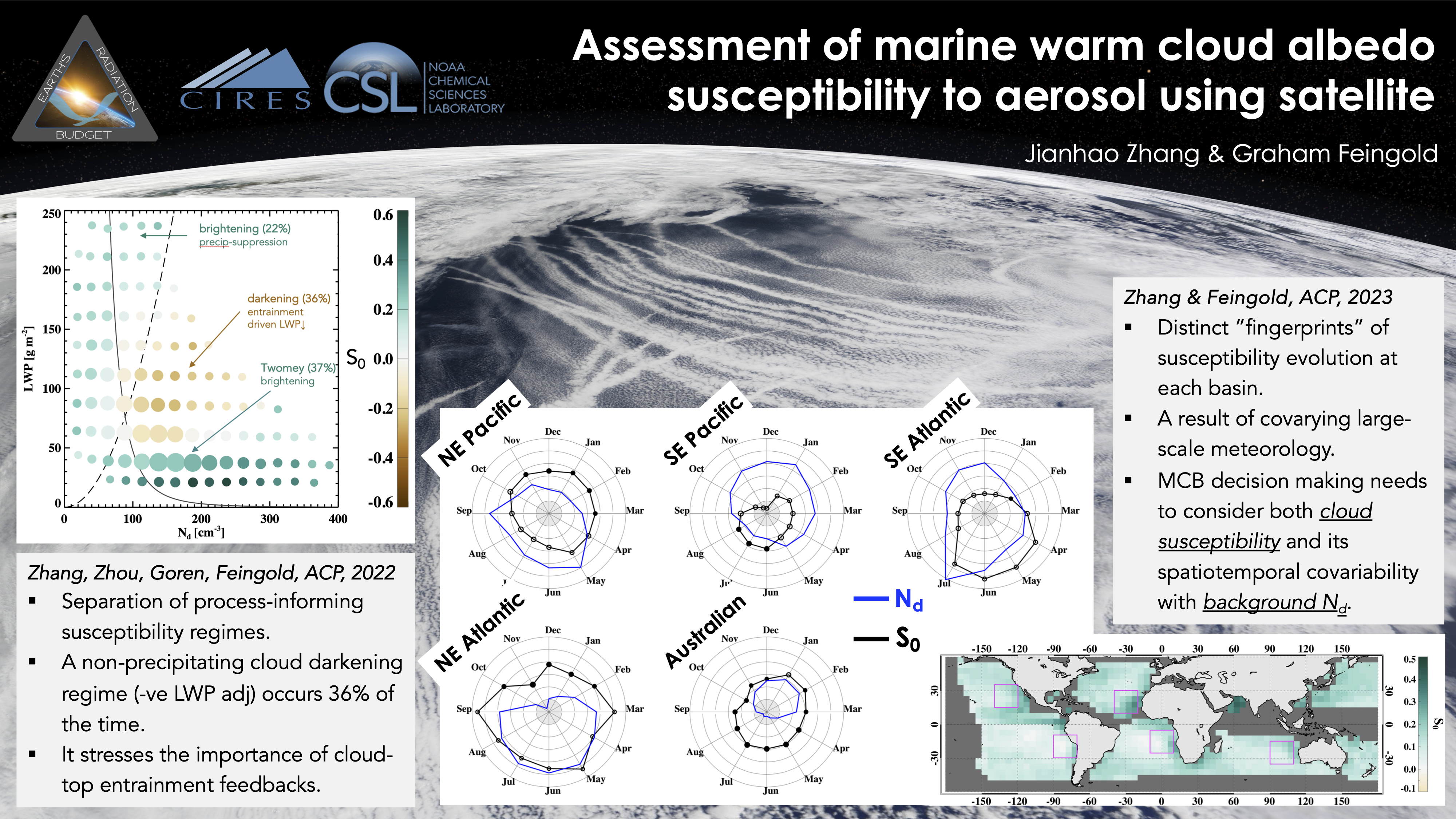Low-Cloud Albedo Susceptibility to Aerosol Perturbations
Characterizing and quantifying aerosol-cloud interactions are fundamental to improving future climate projections and assessing the viability of MCB. In this work, I developed a satellite-based, bottom-up framework for deriving cloud albedo susceptibility that controls for co-varying meteorological factors. This method revealed three distinct, physically-supported susceptibility regimes, their meteorological drivers, and their spatiotemporal variability across marine low-cloud regions.
The Science The sensitivity of cloud brightness (ability to cool the Earth through reflecting sunlight) to the amount of aerosol (tiny particles in the atmosphere) in the marine boundary layer is quantified using spaceborne observations of clouds and radiation. When clouds are sorted by their amount of water condensate and number of droplets, cloud regimes emerge, distinguished by their potential to be brightened or darkened in response to an aerosol perturbation. These regimes include (i) thin non-precipitating clouds that exhibit brightening, where the Twomey effect is expected to dominate; (ii) thicker non-precipitating clouds that exhibit darkening, where microphysically driven entrainment feedbacks are expected to be the most active; and (iii) mostly precipitating clouds that exhibit brightening, consistent with the precipitation-suppression mechanism due to reduced drop sizes.
We find that this regime manifestation in the LWP-Nd space is robust across different subtropical ocean basins where marine stratocumuli prevail. We further demonstrate that the covariation among synoptic scale environmental conditions dictates how clouds populate each regime, leading to regionally distinct evolutions in cloud brightness sensitivity to aerosol changes.

The Impact Marine low-level liquid-form clouds cool the Earth effectively by reflecting a good fraction of sunlight that would otherwise be absorbed by the dark ocean. New insights provided by a bottom-up assessment of cloud albedo susceptibility based on satellite observations confront the long-standing impression that more aerosol leads to brighter clouds, the foundation of one of the proposed climate intervention approaches, namely Marine Cloud Brightening (MCB). We demonstrate that under certain meteorological conditions, especially under deep boundary layers and warm SST, clouds can be darkened due to loss of water condensate through enhanced droplet evaporation. Our work stresses the importance of accounting for meteorology-aerosol covariations when assessing the viability of MCB and scaling up local-to-global cloud radiative response to aerosol perturbations. These findings and the assessment approach are now widely recognized and adopted in the field.
Related Publications
-
J. Zhang and G. Feingold (2023): Distinct regional meteorological influences on low-cloud albedo susceptibility over global marine stratocumulus regions. Atmos. Chem. Phys., 23(2), 1073–1090. doi:10.5194/acp-23-1073-2023
-
J. Zhang, X. Zhou, T. Goren, and G. Feingold (2022): Albedo susceptibility of northeastern Pacific stratocumulus: the role of covarying meteorological conditions. Atmos. Chem. Phys., 22(2), 861–880. doi:10.5194/acp-22-861-2022
-
X. Zhou, J. Zhang, and G. Feingold (2021): On the importance of sea surface temperature for aerosol-induced brightening of marine clouds and implications for cloud feedback in a future warmer climate. Geophys. Res. Lett., 48(24), e2021GL095896. doi:10.1029/2021GL095896
Enjoy Reading This Article?
Here are some more articles you might like to read next: